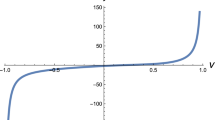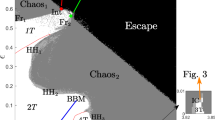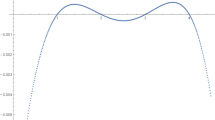Abstract
An explicit method, based on subsequent small perturbations, allowing one to study the algebraic and geometric nature of multiple isolated singularities of a polynomial vector field, is discussed. The main ingredients of the method are (i) establishing a canonical form of a singularity, (ii) explicit decomposition of a compound singularity into simpler ones, and (iii) deriving asymptotic laws of decomposition/collision of singularities. In particular, the saddle-node, pitchfork, and quadruple bifurcations of zeros of a polynomial vector field are considered from the various novel and perhaps unexpected angles. Several examples of subsequent phase portraits illustrating possible interactions between equilibrium of ODEs are also discussed.






Similar content being viewed by others
Data availability
My manuscript has no associated data.
References
Arnol’d, V.I. Singularities, bifurcations, and catastrophes. Bendixson, Soviet Phys. Uspekhi 26 (1983), no. 12, 1025–1037.
Arnol’d, V.I., Goryunov, Lyashko, V. and Vasiliev, V. Singularities I. Local and global theory, Current Problems in Mathematics. Fundamental Directions, Vol. 6, 5-257, Itogi Nauki i Tekhniki, Akad. Nauk SSSR, Vsesoyuz. Inst. Nauchn. i Tekhn. Inform., Moscow, 1988.
Arnol’d, Goryunov, V. Lyashko, O and Vasiliev, V. Singularities II. Classification and Applications, Encyclopedia of Math. Sciences, 39. Springer, 1992 (Russian edition 1989).
Arnol’d, V.I., Varchenko, A.N., and Gusein-Zade, S.M. Singularities of Differentiable Maps. Vol. I , Monographs in Mathematics, 82. Birkhäuser Boston, Inc., Boston, MA, 1985.
Artés, J,; Llibre, J,; Schlomiuk, D,; Vulpe, N. Global configurations of singularities for quadratic differential systems with exactly three finite singularities of total multiplicity four. Electronic Journal of Qualitative Theory of Differential Equations, 2015 (49). pp. 1-60
Balanov, Z.; Krasnov, Y. On good deformations of\(A_m\)-singularities. Discrete Cont. Dyn. Syst. Ser. S 12(7) (2019) pp. 1851-1866.
Balanov, Z.; Kononovich, A.; Krasnov, Y. Projective dynamics of homogeneous systems: local invariants, syzygies, and the global residue theorem. Proc. Edinb. Math. Soc. 55 (2012), no. 3, 577–589.
Berlinskiĭ, A.N. On the behavior of the integral curves of a differential equation. (Russian) Izv. Vysš. Učebn. Zaved. Matematika (1960), no. 2, 3–18.
Coffman, A. Unfolding CR Singularities, Memoirs of the AMS (962) 205 (2010),
Dumortier, F; Llibre, J; Artés, J.C. Qualitative theory of planar differential systems. Universitext. Springer-Verlag, Berlin, (2006). 298 pp.
Giné, J; Llibre, J. A method for characterizing nilpotent centers. J. Math. Anal. Appl. 413 (2014), no. 1, 537–545.
Griffiths, P.; Harris, J. Principles of Algebraic Geometry; Wiley-Interscience: New York, NY, USA, 1978.
Grobman, D.M. Homeomorphism of systems of differential equations. (Russian) Dokl. Akad. Nauk SSSR 128 (1959) 880–881.
Hartman, P. A lemma in the theory of structural stability of differential equations. Proc. Amer. Math. Soc. 11 (1960) 610–620.
Hironaka H. Resolution of singularities of an algebraic variety over a field of characteristic zero: I Ann. of Math. 79, 1964, 109–203
Ilyashenko, Y and Yakovenko, S. Lectures on Analytic Differential Equations, Graduate Studies in Mathematics, 86. American Mathematical Society, Providence, RI, 2008.
Krasnov, Y; Kononovich, A.; Osharovich, G. On a structure of the fixed point fixed-point set of homogeneous maps. Discrete Contin. Dyn. Syst. Ser. S 6 (2013), no. 4, 1017–1027.
Krasnov, Y. Properties of ODEs and PDEs in algebras, Complex Analysis and Operator Theory: 7, no. 3, 623-634, 2013.
Krupa M. and Szmolyan P. Extending geometric singular perturbation theory to nonhyperbolic points - fold and canard points in two dimensions SIAM J. Math. Anal. 33, 2001, 286-314
Krupa M. and Wechselberger M. Local analysis near a folded saddle-node singularity J. Differential Equat. 248, (2010), 2841-2888
Kuehn, C. A remark on geometric desingularization of a nonhyperbolic point using hyperbolic space, Journal of Physics: Conference Series, 727,
Murdock, J. Normal forms and unfolding for local dynamical systems. Springer Monographs in Mathematics. Springer-Verlag, New York, (2003). 494 pp.
Nestruev, J. Smooth Manifolds and Observables. Graduate Texts in Mathematics. 220, (2020). 433 pp.
Zoladek, H. Analytic ordinary differential equations and their local classification, in Handbook of Differential Equations: Ordinary Differential Equations, Elsevier/North-Holland, Amsterdam, 4 (2008), 593-687.
Acknowledgements
The author is grateful to the anonymous referees for numerous and informative remarks, which made it possible to significantly improve the quality of the results obtained in this work.
Author information
Authors and Affiliations
Corresponding author
Ethics declarations
Competing interests
The author declares no competing interests.
Additional information
Publisher's Note
Springer Nature remains neutral with regard to jurisdictional claims in published maps and institutional affiliations.
Appendix
Appendix
We start first with phase portraits of a saddle-node bifurcation, that is, in fact, a collision and disappearance of two equilibria in dynamical systems generated by autonomous ODEs,
Examples of a system with a semi-hyperbolic singularity
After splitting the point, one obtains two simple points: a node and a saddle. The absolute values of the Jacobian determinants are equal (in general, asymptotically identical). The signs of the determinants, however, are always opposite.
An example of a system with a nilpotent singularity
Splitting a singularity of multiplicity 2 along a straight line into two simple, singular points, it is easy to see that the type of critical point is a cusp tip, which is a combination of the simple singular points: a center and a saddle (Fig. 7).
For different systems, whose \(\overrightarrow{{p}}\left( x_1\right)\) vectors are identical, one can see a change in the type of the critical point splitting. In the first, the point splits into a saddle and a focus. In the second system, the point splits — into a saddle and a center (see Fig. 8) (although both systems are obtained from imaginary eigenvalues). This phenomenon is known as the center-focus problem, as written in [10] (Fig. 9).
Decomposition of singularity of multiplicity 4
We presented three different scenarios of possible splitting of an isolated singularity of multiplicity 4 [5] in Figs. 10 and 11.
Rights and permissions
Springer Nature or its licensor (e.g. a society or other partner) holds exclusive rights to this article under a publishing agreement with the author(s) or other rightsholder(s); author self-archiving of the accepted manuscript version of this article is solely governed by the terms of such publishing agreement and applicable law.
About this article
Cite this article
Rabinowitz, I. STEP-BY-STEP RESOLUTION OF SINGULARITIES AND STUDYING INTERACTIONS BETWEEN THEM. J Math Sci 266, 723–743 (2022). https://doi.org/10.1007/s10958-022-06056-8
Received:
Revised:
Accepted:
Published:
Issue Date:
DOI: https://doi.org/10.1007/s10958-022-06056-8









